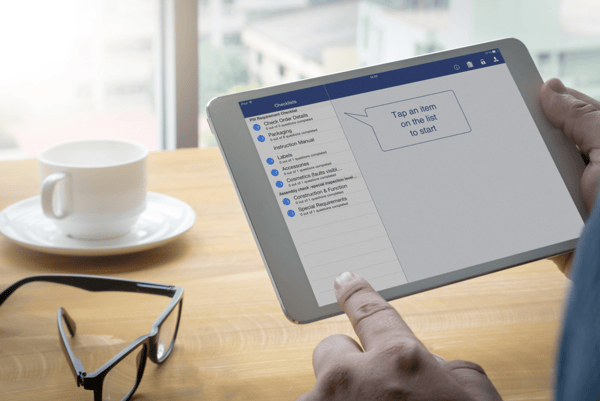Want to contribute to this article?
As any paper salesman will tell you, paper is still the core of business documentation management.
Every day, one billion photocopies are made. The USA alone houses over four trillion paper documents - and Gartner estimates businesses are increasing their average paper documentation output by 25% every year.
But modernised, paperless business processes are expanding too. 'Going paperless' offers businesses a series of distinct advantages, from cost-cutting to tightening information security.
Here are five reasons your business should join the 'paper to pixels' movement.

1. Improved quality management
Any competent and effective quality management system requires rapid, simple traceability of information. From checking a policy or procedure to tracking a batch of manufactured product, electronic paperless systems allow information to be quickly identified and acted on.
As quality issues like customer complaints, product recalls and audit non-conformances arise, getting off the paper trail and into the world of paperless - think automated, electronic workflows and email notifications - drives much quicker and coordinated responses. No more passing a piece of paper from office to office to get things done.
2. The environmental impact
We hear about it all the time. Use less electricity, and so fewer fossil fuels. Use less paper, and save the trees.
There's no doubt that eliminating paper from the modern office will have wider environmental benefits, as fewer trees are felled to support vast amounts of paper expenditure. In an age of increased environmental uncertainty, there's a lot to be said for this and initiatives like World Paper Free Day aim to promote the benefits of wasting less paper.
Nevertheless, aside from a few particularly environmentally-conscious businesses, saving the trees isn't the primary factor most companies will consider for going paperless.
More and more businesses are going paperless primarily to:
- Optimise their processes
- Boost efficiency
- Minimise expenditure
Which brings us to...
3. It saves money and time
Money doesn't grow on trees. In fact paper constitutes a significant expenditure in both raw costs and associated paperwork management time.
Buying, completing, filing, sorting and sharing paper documentation costs time and money. A study in the U.S. found for every dollar spent on paper - and the average office worker goes through 10,000 sheets a year - another six are spent on management, handling and distribution.
It's not surprising that eliminating paper-based processes has a beneficial impact on the company finances and operational efficiency.
Qualsys customer Sodexo presented the impact of their electronic quality management system on their business processes at the AIIM 2017 conference. IT Systems Manager Rob Gibson noted that:
One of our team has to go out on site and do lots of very detailed audits using the iEQMS Auditor application. Then he has to write a formal report about the findings. It used to take three days. Now it's automatically produced the same day. That's a really powerful story.
Along with the burden of compiling paper documentation, AIIM estimates that a further half hour per employee per day is lost searching for documentation. Organising electronic documentation into a repository removes this burden and promotes more efficient, profitable working.
Of course, electronic systems cost money as well. But the sum total of costs including:
- Paper
- Administration and searching time
- Filing cabinets, boxing and storage
- Rental cost of office space for document storage
make paperless solutions increasingly cost-effective for the modern business.
MedTech Intelligence found a cardiac resuscitation device company experienced an annual reduction of £61,000 in paperwork management as well as an annual drop of £22,800 in paper costs, storage and boxing costs after migrating to an electronic document management solution. That's far more than the solution cost them.

Electronic systems cost money too - but eliminating paper costs means they can pay for themselves in months
4. It's more secure
Paper documents are inherently less secure and easier to access than digital documentation.
You might have seen the recent leak of Mark Zuckerberg's senate hearing notes. A confidential binder of information for presentation to a joint committee was photographed and went viral as an aide moved to close it - an ironic breach of data as Mr Zuckerberg attempted to explain Facebook's involvement in the recent Cambridge Analytica scandal.

The misuse of digital data took a political consultancy firm. The misuse of paper documentation took a single camera.
Businesses looking to tighten their information security for ISO 27001 compliance or manage their data risks for ISO 31000 will find their job much easier with a paperless repository.
Migrating business documentation to an electronic format like Qualsys's document management module means:
- Version control: multiple circulating versions of the same document can be eliminated with a single source of truth
- Controlled viewing permissions: paper like Mr Zuckerberg's notes can be read by anyone. Navigational trees with bespoke viewing permissions mean electronic documents are only seen by who needs to see
- Change control: amendment records and trails remove the impact of human error or misuse while enforcing accountability
Which all help with...
5. The GDPR
There are now just 39 days until the GDPR is enforced. The Information Commissioner's Office is expecting businesses to have taken the necessary steps to make the personal data they hold secure, private and controlled by 25 May. Or as they put it:
We would like to see more organisations integrating core privacy considerations into existing project management and risk management methodologies and policies.
Still managing your projects and business processes with paper that could be misplaced, lost, destroyed or misused?
Now's the time to become GDPR-compliant with 'privacy by design'. For the ICO, 'privacy by design' means baking data protection into your business management, rather than simply bolting it on as an afterthought (like locking your filing cabinets).
A secure, electronic document management system is a great example of privacy by design. There isn't much time left to get ready for GDPR - so understanding how and where data is managed within your business should be a top priority.
Building a register or completing a privacy impact assessment becomes much simpler with a single paperless source of information to assess.
What to do next
Considering a paperless solution for your business? Product Quality Assurance Manager Kate Armitage explains how to find the electronic solution that works for you in our GRC software buying guide.
Access our free whitepaper 'The Case For Document Management' for more information about why paperless document control is more crucial than ever.
Want to speak to us about our electronic document management solution?





Share your thoughts on this article